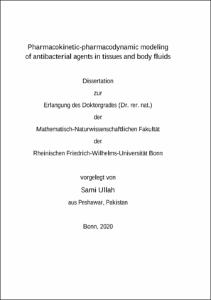Ullah, Sami: Pharmacokinetic-pharmacodynamic modeling of antibacterial agents in tissues and body fluids. - Bonn, 2020. - Dissertation, Rheinische Friedrich-Wilhelms-Universität Bonn.
Online-Ausgabe in bonndoc: https://nbn-resolving.org/urn:nbn:de:hbz:5-60421
Online-Ausgabe in bonndoc: https://nbn-resolving.org/urn:nbn:de:hbz:5-60421
@phdthesis{handle:20.500.11811/8816,
urn: https://nbn-resolving.org/urn:nbn:de:hbz:5-60421,
author = {{Sami Ullah}},
title = {Pharmacokinetic-pharmacodynamic modeling of antibacterial agents in tissues and body fluids},
school = {Rheinische Friedrich-Wilhelms-Universität Bonn},
year = 2020,
month = nov,
note = {The aim of this thesis was to assess the pharmacokinetic / pharmacodynamics (PK/PD) of anti-bacterial agents in tissues and body fluids through non-linear mixed effects (NLME) modeling.
In the first project, a population pharmacokinetic (PopPK) model of telavancin was developed to describe its total concentrations in plasma and its unbound concentrations in plasma, muscle and subcutaneous tissue in 8 healthy volunteers measured by microdialysis. Monte Carlo simulations (MCS) based on the model suggested that the proposed pharmacodynamic targets to successfully treat relevant bacterial infections are achieved in plasma and muscle tissue with the current dosing (10 mg/kg daily).
Secondly, a PopPK model was developed for piperacillin (an anti-pseudomonal penicillin) based on its concentrations in extracellular fluid (ECF) of the brain measured by microdialysis after single and multiple doses in 10 acute hemorrhagic stroke patients. MCS suggested that the concentrations achieved in brain are far too low to provide efficacy against important bacteria such as pseudomonas aeruginosa. Interestingly, changing the rate of infusion had only minimal effect on brain exposure of piperacillin.
The last project aimed at improving the treatment of bacterial infections of critically ill patients. While the kidney is a frequent target of disease in such patients, assessment of their renal function is not trivial mainly because it is not stable. Therefore, conventional equations to predict creatinine clearance (CrCL) such as Cockcroft-Gault cannot be used as they assume a steady state condition. While measured CrCL (mCrCL) is generally considered a gold standard method, it requires urine collection which is highly error-prone. As an alternate procedure, a one-compartment NLME model for creatinine was developed based on serum and urine concentrations, with zero-order generation rate (CGR) and first order elimination. A novel auto-regressive approach was used to describe inter-occasion variability in creatinine clearance. The creatinine model was then used as a covariate to explain the pharmacokinetic variability in clearance of cefepime and meropenem. In this respect, the creatinine model performed better than the conventional approaches.
In conclusion, all models developed provided valuable information for the assessment and improvement of antibacterial treatment.},
url = {https://hdl.handle.net/20.500.11811/8816}
}
urn: https://nbn-resolving.org/urn:nbn:de:hbz:5-60421,
author = {{Sami Ullah}},
title = {Pharmacokinetic-pharmacodynamic modeling of antibacterial agents in tissues and body fluids},
school = {Rheinische Friedrich-Wilhelms-Universität Bonn},
year = 2020,
month = nov,
note = {The aim of this thesis was to assess the pharmacokinetic / pharmacodynamics (PK/PD) of anti-bacterial agents in tissues and body fluids through non-linear mixed effects (NLME) modeling.
In the first project, a population pharmacokinetic (PopPK) model of telavancin was developed to describe its total concentrations in plasma and its unbound concentrations in plasma, muscle and subcutaneous tissue in 8 healthy volunteers measured by microdialysis. Monte Carlo simulations (MCS) based on the model suggested that the proposed pharmacodynamic targets to successfully treat relevant bacterial infections are achieved in plasma and muscle tissue with the current dosing (10 mg/kg daily).
Secondly, a PopPK model was developed for piperacillin (an anti-pseudomonal penicillin) based on its concentrations in extracellular fluid (ECF) of the brain measured by microdialysis after single and multiple doses in 10 acute hemorrhagic stroke patients. MCS suggested that the concentrations achieved in brain are far too low to provide efficacy against important bacteria such as pseudomonas aeruginosa. Interestingly, changing the rate of infusion had only minimal effect on brain exposure of piperacillin.
The last project aimed at improving the treatment of bacterial infections of critically ill patients. While the kidney is a frequent target of disease in such patients, assessment of their renal function is not trivial mainly because it is not stable. Therefore, conventional equations to predict creatinine clearance (CrCL) such as Cockcroft-Gault cannot be used as they assume a steady state condition. While measured CrCL (mCrCL) is generally considered a gold standard method, it requires urine collection which is highly error-prone. As an alternate procedure, a one-compartment NLME model for creatinine was developed based on serum and urine concentrations, with zero-order generation rate (CGR) and first order elimination. A novel auto-regressive approach was used to describe inter-occasion variability in creatinine clearance. The creatinine model was then used as a covariate to explain the pharmacokinetic variability in clearance of cefepime and meropenem. In this respect, the creatinine model performed better than the conventional approaches.
In conclusion, all models developed provided valuable information for the assessment and improvement of antibacterial treatment.},
url = {https://hdl.handle.net/20.500.11811/8816}
}






